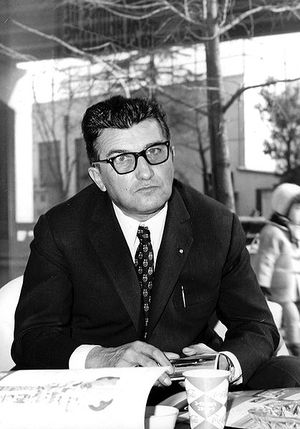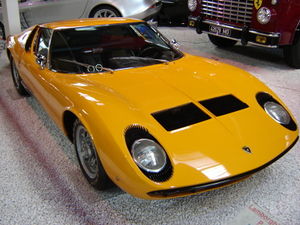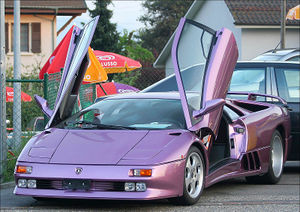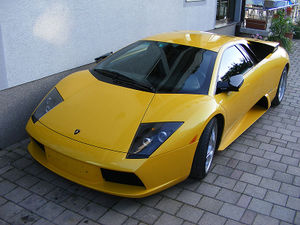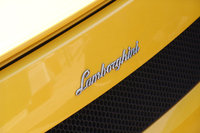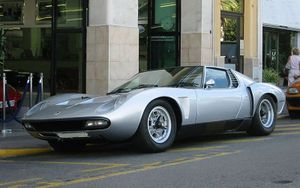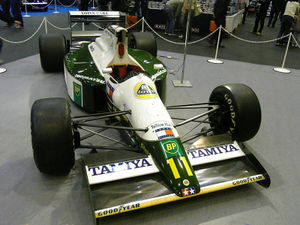Difference between revisions of "Lamborghini"
m |
m |
||
| (4 intermediate revisions by the same user not shown) | |||
| Line 1: | Line 1: | ||
{{X}} | {{X}} | ||
[[image:LamborghiniLogo.gif|center|90px]] | [[image:LamborghiniLogo.gif|center|90px]] | ||
| − | [[image:Lambo_Diablo_WOI.jpg|thumb| | + | {| border=1 cellspacing=3 cellpadding=4 style="float:right; margin:0 0 .5em 1em; width:300px; background:#505050; border-collapse:collapse; border:1px solid #999; font-size:83%; line-height:1.5; " summary="Infobox Automobile" |
| + | |- style="text-align:center; background:#505050;" | ||
| + | | colspan=2 style="padding:0; background:#808080; color:#fff; border-bottom:1px solid #999;" |<videoflash>XwhcFGOXc9c|300|200</videoflash> | ||
| + | |- style="color:#fff; background:darkred; font-size:larger;" | ||
| + | ! colspan=2 |'''History of Lamborghini''' | ||
| + | |} | ||
| + | |||
| + | [[image:Lambo_Diablo_WOI.jpg|thumb|290px|right|'''Lamborghini Diablo at [http://www.woiow.com Wheels Of Italy]]]''' | ||
| Line 234: | Line 241: | ||
[[Lamborghini Value in Italy (Euro)]] | [[Lamborghini Value in Italy (Euro)]] | ||
| − | |||
| − | |||
| Line 249: | Line 254: | ||
* [http://www.premier-motorcars.com '''Great Place to Buy Your Lambo'''] | * [http://www.premier-motorcars.com '''Great Place to Buy Your Lambo'''] | ||
| − | [[Image:4102_2737 copy.jpg|right| | + | [[Image:4102_2737 copy.jpg|right|105px]] |
{{Lamborghini}} | {{Lamborghini}} | ||
{{Lamborghini early timeline}} | {{Lamborghini early timeline}} | ||
{{Lamborghini modern timeline}} | {{Lamborghini modern timeline}} | ||
| + | |||
| + | |||
| + | {{-}} | ||
| + | Send what you have to: | ||
| + | *[mailto:Info@WheelsofItaly.com '''info@wheelsofitaly.com'''] | ||
| + | |||
| + | |||
{{-}} | {{-}} | ||
{{A-Z multipage list|Car Information and Photos by Marque|Information and Photos by Marque|}} | {{A-Z multipage list|Car Information and Photos by Marque|Information and Photos by Marque|}} | ||
{{A-Z multipage list|Motorcycle Information and Photos by Marque|Motorcycle Information and Photos by Marque|}} | {{A-Z multipage list|Motorcycle Information and Photos by Marque|Motorcycle Information and Photos by Marque|}} | ||
| + | <br> | ||
{{Car Information and Photos by Marque}} | {{Car Information and Photos by Marque}} | ||
{{Motorcycle Information and Photos by Marque}} | {{Motorcycle Information and Photos by Marque}} | ||
| − | [[Category: | + | |
| − | [[Category: | + | [[Category:Car manufacturers of Italy]] |
| + | [[Category: Cars]] | ||
Latest revision as of 08:47, 6 November 2011
| History of Lamborghini |
|---|
Automobili Lamborghini S.p.A., commonly referred to as Lamborghini, is an Italian manufacturer of high performance sports cars (supercar) based in the small Italian village of Sant'Agata Bolognese, near Bologna. Lamborghini is now a subsidiary of German car manufacturer Audi AG, which is in turn a subsidiary of Volkswagen. Lamborghini is the main counterpart to Ferrari in the Italian sports car business. The Italian company was founded in 1963 by businessman Ferruccio Lamborghini (April 28, 1916 February 20, 1993), who owned a successful tractor factory, Lamborghini Trattori S.p.A..
History
Origin
As owner of a successful tractor and heating unit manufacturing business in the wake of World War II, Ferruccio Lamborghini was able to cultivate an interest in sports cars. After owning a Mercedes-Benz 300SL, a Jaguar E-Type, and a Maserati 3500GT, he bought his first Ferrari, a 250GT. He quickly became a Ferrari enthusiast, eventually coming to own three 250GTs. However, he frequently encountered problems with the cars, specifically the clutch mechanism. He brought his complaints directly to company owner Enzo Ferrari, who took great offense at the notion of a tractor manufacturer criticizing the design of his precious cars, and let Lamborghini know as much, quoted as having said "the problem is not with the car, but rather, the driver". Insulted by Ferrari's reaction, Lamborghini took it upon himself to repair his car's clutch; in the process, he discovered that the design shared components with the clutches in the tractors manufactured by his own company. Encouraged by his discovery, and his desire to spite Ferrari, Lamborghini became inspired to create a grand tourer that would rival Ferrari's designs. He called upon the talents of automobile engineers Giotto Bizzarrini and Gian Paolo Dallara, designer Franco Scaglione, and an experienced driver from New Zealand, Bob Wallace. Together, they developed a prototype automobile, the 350GTV, which would evolve into the first production Lamborghini, the 350GT; Automobili Lamborghini was born.
Under Ferruccio Lamborghini
Ferruccio Lamborghini's fledgling automaker quickly achieved success with the 350GT, which the company soon followed up with the 400GT in 1966, along with Lamborghini's first truly iconic car, the flagship Miura, which set a precedent for mid-engined two-seater high performance sports cars. The Miura was joined two years later by a four-seat grand tourer, the Espada, and a replacement for the 400GT, the Islero. After only two years in production, the Islero was itself replaced by the Jarama, which was designed to take into account new U.S. safety and emissions legislation. 1970 also saw the introduction of the Urraco, a 2+2 that slotted just beneath the Miura in Lamborghini's lineup.
1972 saw the first major setback for Ferruccio Lamborghini, as a massive tractor order from a South American buyer fell through. Lamborghini had invested heavily in his factories to accommodate the expected increase in demand; the ensuing debt forced him to sell part of his share in the tractor factory to the Fiat group. Eventually, the entire business was acquired by Italian tractor manufacturer Same Deutz-Fahr, which continues to make Lamborghini tractors today. That same year, Lamborghini partnered with investor Georges-Henri Rossetti in his still profitable sports car business; he later sold his remaining share in Automobili Lamborghini to Swissman René Leimer, and left the automotive industry, retiring to a gentleman farmer's life on a vineyard.

Bankruptcy, Mimran, and Chrysler
The 1973 oil crisis plagued the sales of high performance cars from manufacturers around the world; the rising price of oil caused governments to mandate new fuel economy laws and consumers to seek smaller, more practical modes of transportation. As an automaker which produced V8 and V12-powered luxury sports cars with typically abysmal fuel efficiency, the effect on Lamborghini's business was devastating. In 1978, the company declared bankruptcy; an Italian court was appointed to find a buyer, and in 1984 the Swiss-based Mimran brothers took over the company, after having managed it for four years while it was in receivership. The company remained solvent under the Mimrans' control, releasing the famous scissor door-equipped Countach in 1974, evolutions of the Urraco, the Silhouette and the Jalpa, and the rare LM002 sport utility vehicle in 1986.
In a surprising move, the company was bought by the Chrysler Corporation in 1987, with the acquisition being driven by Lee Iacocca, Chrysler's chairman at the time. At the time, Lamborghini was working on a successor, the Diablo. The Diablo's original design had been penned by famed Italian designer Marcello Gandini, who had also developed the exterior appearances of the Miura and the Countach while working for the Italian coachbuilder Bertone. However, Chrysler executives, unimpressed with Gandini's work, commissioned the American car-maker's own design team to execute a third extensive redesign of the car's body, smoothing out the trademark sharp edges and corner's of Gandini's original design; the Italian was left famously unimpressed with the finished product. On the positive side, Chrysler's experience improved areas which had previously been left neglected, including noise, vibration, and harshness (NVH) engineering, manufacturing techniques, practicality, and ergonomics. The Diablo was released to the public on January 21, 1990, at an event at the Hotel de Paris in Monte Carlo.
Post-Chrysler: Megatech and Audi
In January 1994, poor economic circumstances and internal political climate forced Chrysler to sell Lamborghini to Megatech, an Indonesian investment group headed by Tommy Suharto, the youngest son of then-Indonesian President Suharto. A new management team, headed by ex-Lotus Group chief executive Mike Kimberley and ex-McLaren Cars head of sales Nigel Gordon-Stewart. Kimberley was well known to senior Chrysler management from his previous roles at Lotus and General Motors.
Under new ownership and management, Lamborghini's worldwide presence underwent sweeping changes, with its international dealer network and marketing strategies undergoing a complete revision. Sales tripled from just 101 cars in 1993 to 301 in 1994, and grew again to 414 in 1995. Cars sold well thanks to aggressive, proactive marketing programs, which reinforced the exclusive image and premium value that Lamborghini cars came to embody.
Lamborghini would release no all-new cars during the difficult decade of the 90s. In 1995, an upgrade to the Diablo, the Diablo SV (Sport Veloce) was launched. Inspired by the Miura SV, the newest Diablo featured a more powerful V12 engine, and became the best-selling version of Lamborghini's flagship car. However, after only one year of Indonesian ownership, Mike Kimberley's business plan found itself without funding, as changing economic conditions led Megatech, which would later become notorious for allegedly running American supercar maker Vector Motors into the ground, to sell its shares in the Italian company. After only three years under the combined ownership of companies V'Power and Mycom Sedtco, Lamborghini was purchased by German automaker Audi AG, who had gained interest in the Italian company after being approached as possible component suppliers for future Lamborghini models. After a series of complex transactions, Audi became the sole owner of the troubled Italian company.
In much the same way that American ownership had influenced the design of the Diablo, Lamborghini's new German parent played a large role in the creation of the Diablo's replacement. The first new Lamborghini in more than a decade, the Murciélago was also named for a famed fighting bull, and was styled by Belgian Luc Donckerwolke, Lamborghini's new head of design.
Under German ownership, Lamborghini found stability that it had not seen in many years. The automaker's cars, which despite being exotic and endearing were notoriously unreliable, benefited from renowned German engineering knowledge and have resulted in the production of cars that preserve Italian eccentricity while displaying the hallmarks of German efficiency. In 2003, Lamborghini followed up the Murciélago with the smaller, V10-equipped Gallardo, intended to be a more accessible and more livable than the Murciélago. The latest all-new model to be released was the Reventón, an extremely limited-edition supercar that carries the distinction of being the most powerful and expensive Lamborghini ever sold. In 2007, Wolfgang Egger was appointed as the new head of design of Audi and Lamborghini, replacing Walter de'Silva, who was responsible for the design of only one Lamborghini, the Miura Concept of 2006. The newest Lamborghini car is the 2009 Murciélago LP 670-4 SV, a highly refined model that marks the end of the Murciélago's eight-year production run; a replacement for Lamborghini's halo car is expected in 2010.
Partnerships
In 2006, Lamborghini partnered with Asus to produce the Asus Lamborghini VX series of notebook computers. The current VX notebooks are VX1 and VX2. Both feature the Lamborghini logo on the lid, and both are relatively powerful, with the later VX2 featuring a Core 2 Duo processor clocked at 2.16 GHz, 2GB of DDR2 RAM, and an nVidia GeForce Go 7700 graphics card with 512MB
Models
Lamborghini's products include the 350GTV (1963), 350GT (1964), 400GT 2+2 (1966), Miura (1966), Espada (1968), Jarama (1970), Countach (1974), Silhouette (1976), Jalpa (1981), Diablo (1990) and the Murciélago (2001) as well as the Lamborghini LM002 (1986) off-road vehicle of which Road and Track magazine said, "With the 5.2 litre V-12, the LM002 can pass anything on the road—except a gas station".
The current (2005) range consists of the Murciélago, the Murciélago Roadster and the smaller, cheaper Gallardo. All are very fast, mid-engined 2-seaters with four-wheel-drive as standard. The styling is largely the work of Belgian designer Luc Donckerwolke.
Model List and Pics
| Vehicle | Year | Engine | Displacement |
|---|---|---|---|
| 350GT | 1964-1968 | Lamborghini V12 | 3464 cc |
| 400GT | 1964-1968 | Lamborghini V12 | 3929 cc |
| Miura | 1966-1973 | Lamborghini V12 | 3929 cc |
| Espada | 1968-1978 | Lamborghini V12 | 3929 cc |
| Islero | 1968-1970 | Lamborghini V12 | 3929 cc |
| Jarama | 1970-1978 | Lamborghini V12 | 3929 cc |
| Urraco | 1970-1979 | Lamborghini V8 | 2463 cc / 2996 cc / 1994 cc |
| Countach | 1974-1989 | Lamborghini V12 | 3929 cc / 4754 cc / 5167 cc |
| Silhouette | 1976-1977 | Lamborghini V8 | 2996 cc |
| Jalpa | 1982-1989 | Lamborghini V8 | 3485 cc |
| LM002 | 1986-1992 | Lamborghini V12 | 5167 cc |
| Diablo | 1990-2000 | Lamborghini V12 | 5707 cc |
| Murciélago | 2002-Present | Lamborghini V12 | 6192 cc |
| Gallardo | 2003-Present | Lamborghini V10 | 4961 cc |
| Reventón | 2008 | Lamborghini V12 | 6496 cc |
New Models and New Prototypes
Concept Cars by Italdesign
Lamborghini's outrageous supercar models have brought Lamborghini much fame. The Miura, the Countach, the Diablo, and the Murciélago, continue to be some of the most desired super cars of all time. The current (2007) range consists of the Murciélago LP640, the Murciélago LP640 Roadster and the smaller, less expensive Gallardo, Gallardo Spyder and Gallardo Superleggera. All are extremely fast, mid-engined 2-seaters with Lamborghini's standard all-wheel drive systems. Their styling is largely the work of Belgian designer Luc Donckerwolke. Future models may include a rear-wheel-drive version of the Gallardo and possibly an SUV in the spirit of the LM002 might also appear. The next generation of Lamborghini models will be penned by Walter de'Silva, who designed the 2006 Miura concept car and who replaced Luc Donckerwolke as head of Centro Stile Lamborghini, Lamborghini's in-house design department.
The bullfighting legacy
The company's crest, which prominently features a bull, was taken from Ferruccio's zodiac sign, Taurus. After producing two cars with alphanumeric designations, Lamborghini decided to name his next car, the Miura, after a famous breeder of fighting bulls, Don Eduardo Miura. The Islero was named after the Miura bull that killed famed matador Manolete on August 28, 1947. The Espada was named for the matador's espada, the sword he uses to slay the bull, a word which is also used colloquially for the matadors themselves. The Jarama's name had an interesting double meaning: Jarama is an area renowned both for its bullfighting history and for its motor racing circuit.
After years of salutes to the world of bullfighting, Lamborghini broke from tradition in 1974. The Countach was named not for a bull, but for countach! (Template:Pronounced), an exclamation of astonishment in the local Piedmontese language — generally used by men upon seeing an extremely beautiful woman. Legend has it that Nuccio Bertone uttered the word in surprise upon first laying eyes on "Project 112", which would become the Countach.
Later company owners reverted back to bullfighting associations. The Diablo was also named for a fighting bull, as was the Murciélago's namesake. The Gallardo is named for a bull caste ancestral to the Miura breed, and the rare Reventón carries the name of the bull that defeated matador Félix Guzmán in 1943.
Motorsport
See also Modena (racing team)
In contrast to his rival Enzo Ferrari, Ferruccio Lamborghini had decided early on that there would be no factory-supported racing of Lamborghinis, viewing motorsport as too expensive and too draining on company resources. This was unusual for the time, as many sports car manufacturers sought to demonstrate the speed, reliability, and technical superiority through motorsport participation. Enzo Ferrari in particular was known for considering his road car business merely a source of funding for his participation in motor racing. Ferrucio's policy led to tensions between him and his engineers, many of whom were racing enthusiasts; some had previously worked at Ferrari. The engineers decided to ignore their chief's whims, using their spare time to develop a mid-engined car with racing pedigree. Lamborghini soon learned of the project, and decided to allow the men to continue their project, with the continued insistence that no racing models would be allowed. Ironically, when the engineers' pet project was released as a production model a few years later, it would become the car that would propel the automaker to widespread fame and set the benchmark for future high-powered sports cars; that car was the Miura.
The closest the company came to building a true race car under Lamborghini's supervision were a few highly modified prototypes, including those built by factory test driver Bob Wallace, such as the Miura SV-based "Jota" and the Jarama S-based "Bob Wallace Special". Under the management of Georges-Henri Rossetti, Lamborghini entered into an agreement with BMW to build a production racing car in sufficient quantity for homologation. However, Lamborghini was unable to fulfill its part of the agreement. The car was eventually developed in-house by the BMW Motorsport Division, and was manufactured and sold as the BMW M1.
In the 1980s, Lamborghini developed the QVX for the 1986 Group C championship season. One car was built, but lack of sponsorship caused it to miss the season. The QVX competed in only one race, the non-championship 1986 Southern Suns 500 km race at Kyalami in South Africa, driven by Tiff Needell. Despite the car finishing better than it started, sponsorship could once again not be found and the program was cancelled.
Lamborghini was an engine supplier in Formula One between the 1989 and 1993 Formula One seasons. It supplied engines to Larrousse (1989-1990,1992-1993), Lotus (1990), Ligier (1991), Minardi (1992), and to the Modena team in 1991. While the latter is commonly referred to as a factory team, the company saw themselves as a supplier, not a backer. The 1992 Larrousse–Lamborghini was largely uncompetitive but noteworthy in its tendency to spew oil from its exhaust system. Cars following closely behind the Larrousse were commonly colored yellowish-brown by the end of the race.
In late 1991, a Lamborghini Formula One motor was used in the Konrad KM-011 Group C sports car, but the car only lasted a few races before the project was canceled. The same engine, re-badged a Chrysler by Lamborghini's then parent company, was tested by McLaren towards the end of the 1993 season, with the intent of using it during the 1994 season. Although driver Ayrton Senna was reportedly impressed with the engine's performance, McLaren pulled out of negotiations, choosing a Peugeot engine instead, and Chrysler ended the project.
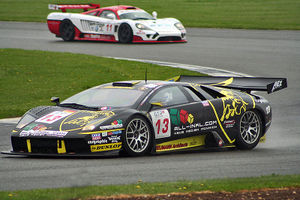
Two racing versions of the Diablo were built for the Diablo Supertrophy, a single-model racing series held annually from 1996 to 1999. In the first year, the model used in the series was the Diablo SVR, while the Diablo 6.0 GTR was used for the remaining three years.
Lamborghini developed the Murciélago R-GT as a production racing car to compete in the FIA GT Championship, the Super GT Championship and the American Le Mans Series in 2004. The car's highest placing in any race that year was the opening round of the FIA GT Championship at Valencia, where the car entered by Reiter Engineering finished third from a fifth-place start. In 2006, during the opening round of the Super GT championship at Suzuka, a car run by the Japan Lamborghini Owners Club garnered the first victory (in class) by an R-GT.
A GT3 version of the Gallardo has been developed by Reiter Engineering.
A Murciélago R-GT entered by All-Inkl.com racing, driven by Christophe Bouchut and Stefan Mücke, won the opening round of the FIA GT Championship held at Zhuhai International Circuit, achieving the first major international race victory for Lamborghini.
Annual sales
| Year | Sales | |||||||||||||||||||||||||||||||||||||||||||||||||
|---|---|---|---|---|---|---|---|---|---|---|---|---|---|---|---|---|---|---|---|---|---|---|---|---|---|---|---|---|---|---|---|---|---|---|---|---|---|---|---|---|---|---|---|---|---|---|---|---|---|---|
| 500 | 1,000 | 1,500 | 2,000 | 2,500 | ||||||||||||||||||||||||||||||||||||||||||||||
| 1996 | 211 | |||||||||||||||||||||||||||||||||||||||||||||||||
| Audi Takeover in 1998 | ||||||||||||||||||||||||||||||||||||||||||||||||||
| 2002 | 424 | |||||||||||||||||||||||||||||||||||||||||||||||||
| 2003 | 1,305 | |||||||||||||||||||||||||||||||||||||||||||||||||
| 2004 | 1,592 | |||||||||||||||||||||||||||||||||||||||||||||||||
| 2005 | 1,600 | |||||||||||||||||||||||||||||||||||||||||||||||||
| 2006 | 2,087 | |||||||||||||||||||||||||||||||||||||||||||||||||
| 2007 | 2,406 | |||||||||||||||||||||||||||||||||||||||||||||||||
| 2008 | 2,430 | |||||||||||||||||||||||||||||||||||||||||||||||||
Ownership
Lamborghini has had a number of owners:
- Ferruccio Lamborghini 1963–1972
- Georges-Henri Rossetti and René Leimer 1972–1977
- bankrupt 1977–1984
- managed by Patrick Mimram 1980–1984
- Patrick Mimram 1984–1987
- Chrysler Corporation 1987–1994
- Megatech 1994–1995 (Permission granted for the Creation of Lamborghini Latinoamerica S.A.)
- V'Power, Mycom 1995–1998
- Audi AG 1998-present
Foreign operations
Automovil Lamborghini de Latin America was set up by a Jorge Antonio Fernandez Garcia in Buenos Aires, Argentina in 1994, It is officially licensed to produce two handbuilt variants of the Diablo called the Eros and the Coatl. They were first produced in 2001 and are available only in Latin America since 2003.
See also: List of Italian companies
Internal Links
Lamborghini Value in Italy (Euro)
External links
- Lamborghini official web site
- Lamborghini by KLD Concept (Photos , vidéo , etc ..)
- The International Lamborghini Registry
- Lamborghini Owners and Enthusiasts forum
- TODOLAMBORGHINI fan site
- LAMBORGHINI weblog
- Timpelen.com - a website dedicated to Automobili Lamborghini
- Lamborghini of Latin America based in Argentina
- Great Place to Buy Your Lambo
| Lamborghini Models | |
|---|---|
| Current models: Reventón | Murciélago LP640 | Murciélago LP640 Roadster | Murcielago Spider | Gallardo | Gallardo Spyder Historic models: Miura | Countach | Diablo | Espada | Silhouette | Jalpa | 350GT | 400GT | Islero | Jarama | LM002 | Urraco Concept models: Athon | Bravo | Cala | Cheetah | Concept S | Flying Star II | 3500GTZ | Genesis | LM001 | LM003 | LM004 | LMA002 | Marco Polo | Marzal | Miura Concept | Portofino | Raptor Owned Group:Volkswagen | Audi | SEAT | Škoda | Bentley | Bugatti | Lamborghini |
| Lamborghini road car timeline, 1960s–1980s | ||||||||||||||||||||||||||||||||||
| Type | 1960s | 1970s | 1980s | |||||||||||||||||||||||||||||||
| 0 | 1 | 2 | 3 | 4 | 5 | 6 | 7 | 8 | 9 | 0 | 1 | 2 | 3 | 4 | 5 | 6 | 7 | 8 | 9 | 0 | 1 | 2 | 3 | 4 | 5 | 6 | 7 | 8 | 9 | |||||
| Owner | and Patrick Mimran |
|||||||||||||||||||||||||||||||||
| FR | GT | 350GT | ||||||||||||||||||||||||||||||||
| 2 plus 2 | 400GT | Islero | Jarama | |||||||||||||||||||||||||||||||
| Coupé | Espada | |||||||||||||||||||||||||||||||||
| RMR | V8/V10 | Silhouette | Jalpa | |||||||||||||||||||||||||||||||
| 2 plus 2 | Urraco | |||||||||||||||||||||||||||||||||
| V12 | Miura | Countach | ||||||||||||||||||||||||||||||||
| SUV | LM002 | |||||||||||||||||||||||||||||||||
| Founder: Ferruccio Lamborghini | Lamborghini Corporate website | A brand of the VWAG group | ||||||||||||||||||||||||||||||||||
| « Previous | Lamborghini road car timeline, 1980s–2000s – part of the Volkswagen Group | ||||||||||||||||||||||||||||||||||||||||||||||||||||||||||||||||||||||||||||||||
| 1980s | 1990s | 2000s | 2010s | ||||||||||||||||||||||||||||||||||||||||||||||||||||||||||||||||||||||||||||||
| 0 | 1 | 2 | 3 | 4 | 5 | 6 | 7 | 8 | 9 | 0 | 1 | 2 | 3 | 4 | 5 | 6 | 7 | 8 | 9 | 0 | 1 | 2 | 3 | 4 | 5 | 6 | 7 | 8 | 9 | 0 | 1 | 2 | 3 | ||||||||||||||||||||||||||||||||||||||||||||||||
| Owner | ← Receivership | and Patrick Mimran |
|||||||||||||||||||||||||||||||||||||||||||||||||||||||||||||||||||||||||||||||
| Mid/RWD | V8 | Jalpa | |||||||||||||||||||||||||||||||||||||||||||||||||||||||||||||||||||||||||||||||
| Mid/4WD | V10 | Gallardo* | |||||||||||||||||||||||||||||||||||||||||||||||||||||||||||||||||||||||||||||||
| Sesto Elemento | |||||||||||||||||||||||||||||||||||||||||||||||||||||||||||||||||||||||||||||||||
| V12 | <··· Countach | Diablo | Murciélago | Aventador | |||||||||||||||||||||||||||||||||||||||||||||||||||||||||||||||||||||||||||||
| Reventón | |||||||||||||||||||||||||||||||||||||||||||||||||||||||||||||||||||||||||||||||||
| Front/4WD | V12 | LM002 | |||||||||||||||||||||||||||||||||||||||||||||||||||||||||||||||||||||||||||||||
| Founder: Ferruccio Lamborghini | Lamborghini Corporate website | A brand of the VWAG group | |||||||||||||||||||||||||||||||||||||||||||||||||||||||||||||||||||||||||||||||||
Send what you have to:
| Car Information and Photos by Marque: A - B - C - D - E - F - G - H - I - J - K - L - M - N - O - P - Q - R - S - T - U - V - W - X - Y - Z |
| Motorcycle Information and Photos by Marque: A - B - C - D - E - F - G - H - I - J - K - L - M - N - O - P - Q - R - S - T - U - V - W - X - Y - Z |
